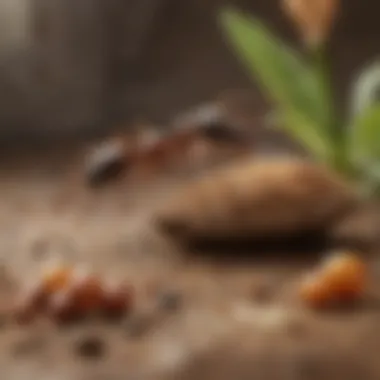Effective Strategies to Eliminate Ants in Your Home


Intro
Ant infestations can be a nuisance in households. Understanding how to effectively eliminate them requires knowledge about their behaviors and environmental triggers. This guide covers practical strategies for managing these pests without harmful chemicals.
Ants are social insects. They operate in colonies and often seek out food and shelter in human homes. Certain conditions attract them, making it essential to comprehend what draws them inside. This article aims to equip readers with detailed insights into their habits, allowing for effective preventative and reactive measures.
"An ounce of prevention is worth a pound of cure."
By grasping ant behavior, homeowners can better respond in reducing these unwanted visitors, ensuring a comfortable living environment.
Understanding Ant Behavior
Understanding the behavior of ants is crucial when addressing infestations in your home. Ants are social insects that thrive in colonies. Their complex social structure and communication methods influence their movement, foraging habits, and nesting choices. Recognizing these patterns helps in developing effective strategies to eliminate ant populations and prevents future invasions. In this part of the article, we will explore the types of ants commonly found indoors, their nesting habits, and the reasons behind their indoor invasions.
Types of Ants Commonly Found Indoors
Different species of ants invade homes for varied reasons. Some of the most common types include:
- Carpenter Ants: Preferring wood, these ants can cause significant damage by nesting within it.
- Pavement Ants: Known for their affinity for nesting under paving stones and sidewalks, they may also venture indoors in search of food.
- Sugar Ants: Attracted to sugary substances, they are often found in kitchens and pantries.
- Pharaoh Ants: These small ants tend to invade buildings, especially in warmer climates, and can thrive in various environments.
Each species has distinct preferences and behaviors which makes tailored strategies essential for removal.
Ant Behavior and Nesting Habits
Ant colonies often establish nests in hidden places such as walls, under floors, and even inside appliances. Their nesting behavior can directly influence how they invade and reside in homes. Carpenter ants, for instance, create nests inside wooden structures, while pavement ants often colonize under outdoor surfaces but forage indoors. Understanding where these nests are and how they behave can aid in targeted elimination efforts. They communicate through pheromones, marking trails to food sources. This means that a small number of ants seen indoors can signal a larger problem.
Reasons for Indoor Invasions
Ants often invade homes in search of food, water, and shelter. Common triggers for these invasions include:
- Food Accessibility: Unsealed food sources attract ants looking for nourishment.
- Moisture: Leaks or damp areas can draw them into a home, especially in search of water.
- Seasonal Changes: During certain times of the year, ants tend to seek out warmer areas for nesting.
Understanding these reasons provides insight into how to prevent and address ant infestations. By addressing the factors that draw them in, one may significantly decrease the chances of an invasion.
Prevention Techniques
Preventing an ant infestation is the core of effective pest control in any home. By addressing the situations that attract ants, such as food availability and nesting spots, homeowners can significantly reduce the likelihood of an invasion. Preventative measures save time and money while creating a more comfortable living environment. Given that treating an existing infestation can often require significant effort and resources, successful prevention is crucial.
Sealing Entry Points
One of the most effective ways to keep ants out is by sealing potential entry points. Ants can exploit the tiniest openings in a home. Cracks in walls, gaps around windows, and holes in floors can all serve as gateways. Homeowners should meticulously inspect these areas and fill the gaps with suitable materials like silicone caulk or foam insulation. Other solutions include installing door sweeps and screens on windows to create a more impenetrable barrier.
Take special note of areas where utility lines enter the building, as these can also provide a path for ants. By sealing entry points, the chances of an ant colony finding its way inside are considerably lowered.
Maintaining Cleanliness
Maintaining a clean home is another key element in ant prevention. Ants are drawn to clutter, crumbs, and residues left behind after meals. Regular cleaning routines should include vacuuming floors and wiping down surfaces to eliminate food particles. Pay attention to areas that might not get frequent cleaning, such as behind appliances and under furniture.
Additionally, outdoor cleanliness is essential. Remove debris, leaves, and standing water from the perimeter of the house. This reduces the food sources available to ants, fostering a less inviting environment.
Proper Food Storage
Proper food storage is a fundamental strategy that can significantly impact ant control. Any food item left open is a potential target for ants. Store all food items in airtight containers to deter these pests. This includes pantry staples like sugar, flour, and pet food. Using containers that ants cannot penetrate will help maintain a secure environment.
Also, ensure that any spills or food residues are cleaned immediately. This creates less opportunity for scent trails that attract more ants. By practicing diligent food storage habits, homeowners can effectively disrupt the attraction factor for ants in their living spaces.


Home Remedies for Ant Elimination
Home remedies provide practical and often cost-effective solutions for ant problems. Many people prefer these methods because they rely on easily obtainable materials that are safe for the environment. Utilizing home remedies can lessen the need for harsh chemicals, promoting a more organic and sustainable approach to pest control. Additionally, these strategies often target ants without disrupting household routines significantly. It is important to consider the benefits of these methods, including safety, accessibility, and effectiveness.
Vinegar Solutions
Vinegar possesses strong acetic acid properties that can disrupt the pheromone trails ants leave for one another. To create a vinegar solution, mix equal parts of white vinegar and water in a spray bottle. Spray this mixture directly on ant trails and nests.
- Application: Spray regularly, focusing on areas where ants are frequently seen.
- Benefits: This solution is non-toxic and can effectively remove the scent trails, causing confusion in the ant colony. The method is simple and requires no specialized knowledge.
It is also worth noting that vinegar's smell dissipates quickly, making it a suitable option indoors. However, continual use may be required, as vinegar does not kill ants but merely repels them temporarily.
Boric Acid and Sugar Baits
Boric acid is a common household chemical that can be lethal to ants when ingested. When combined with sugar, it acts as an attractive bait, drawing ants to it while delivering the acid into their systems. To prepare this bait, mix one part boric acid with three parts sugar and water.
- Usage Instructions: Soak cotton balls in the mixture and place them where ants are present. It's critical to ensure that the bait is out of reach of children and pets.
- Efficacy: Boric acid works slowly, allowing ants to return to their colony and share the bait with others, leading to more effective colony elimination over time.
Boric acid can be very effective in reducing ant populations, but caution is necessary due to its toxic nature to non-target species. The method requires patience, as it may take a few days before significant results are noticed.
Essential Oils as Repellents
Essential oils can serve as natural deterrents for ants. Oils such as peppermint, tea tree, and eucalyptus have strong scents that ants dislike. These oils can interfere with their ability to communicate using pheromones. To use essential oils, mix a few drops with water in a spray bottle and shake well.
- Application: Spray this mixture in areas frequented by ants, especially near entry points and nests.
- Benefits: This method is safe and leaves a pleasant scent in your home, unlike chemical pesticides.
Essential oils can help in preventing future invasions if used regularly. However, they usually require frequent reapplication, especially after cleaning or rainfall.
It's essential to remember that while home remedies can be effective, persistent infestations may require more comprehensive approaches.
By understanding and utilizing these home remedies, individuals can take back control from ant invasions. Experimenting with these methods provides insights into effective pest management while reducing reliance on chemical treatments.
Commercial Pest Control Products
The use of commercial pest control products is a central facet in the battle against ant infestations. These products offer targeted solutions that are often necessary when basic home remedies and preventive measures fail. They are designed to eliminate ants quickly and effectively, providing a strategic advantage in managing larger infestations. Understanding the specific elements of these products, as well as their benefits and considerations, is crucial for effective ant control.
Insecticides and Sprays
Insecticides and sprays are among the most widely utilized commercial options for ant control. These products typically contain chemical compounds that disrupt the normal functioning of an ant's nervous system. Many formulations on the market are designed for indoor use, ensuring they are effective while minimizing risk to human occupants and pets. The application is generally straightforward, often requiring spray around entry points, trails, or nests.
When using insecticides, it is important to follow the manufacturer’s instructions closely. This ensures efficacy while also keeping safety in mind. Additionally, consumers should be aware of the active ingredients in the products. Some common ingredients, like pyrethroids, are effective against a wide range of ant species, but can sometimes lead to pesticide resistance if used excessively.
To minimize risks with insecticides, always consider formulations that offer low toxicity to non-target organisms and effective control against the specific ant species infesting your space.
Ant Baits and Traps
Ant baits and traps are an alternative to traditional insecticides, providing a more targeted approach. Bait products often contain attractants combined with slow-acting poisons that worker ants carry back to the colony. This helps eliminate not only the ants you see but also those hidden deeper in your walls or on your property. The baiting process can take several days to show results, but it is often worth the wait as it targets the queen and the overall colony.
Traps, on the other hand, can capture ants that are already in your home. These devices often come ready to use and can be placed in strategic locations where ants are frequenting. While traps do not eliminate the colony directly, they effectively reduce the number of visible ants and help to assess the severity of an infestation.
Foggers and Fumigation Options
For severe infestations that are difficult to control through localized treatments, foggers and fumigation options may be necessary. Foggers disperse a fine mist of insecticide throughout an area, ensuring penetration into hard-to-reach spaces. This approach is useful in larger homes or commercial properties where ants might have established extensive nests.
Fumigation is a more extreme method, often employing gas-based pesticides that permeate all areas of a structure, reaching even the most hidden nests. While these options can be highly effective, they typically require vacating the premises for a specified amount of time and may necessitate hiring professional pest control services.
Identifying Signs of Infestation


Recognizing the signs of an ant infestation is essential for timely intervention. Early detection of ant populations can prevent larger issues that might follow. Once an infestation starts, ants can reproduce rapidly and increase their numbers swiftly. Understanding the signs can help homeowners take action to eliminate them before a larger problem develops.
Visible Ant Trails
Ants are social insects. Therefore, they travel in groups, forming clear trails to their food sources. These trails are often visible on walls, floors, or countertops. If you notice a line of ants marching in a singular direction, it indicates that they are following a pheromone trail left by fellow ants. This is particularly common when ants have found food. Addressing these trails promptly can help in taking measures to eliminate them. Cleaning the areas with soap and water can disrupt their chemical trail, preventing others from following.
Presence of Ant Nests
Finding an ant nest is a significant indicator of an infestation. Nests can be located both indoors and outdoors. Indoors, they are often found in wall voids, under floors, or in hidden spaces like inside furniture. Outdoors, nests might be near foundations or gardens. If you see small piles of dirt or debris, this might be a sign of an ant nest. Identifying the location of the nest can not only provide insight into the species but also point to where extermination efforts should be focused. Knowing the nest location speeds up the elimination process.
Damage to Property
Ants can cause notable damage to your home. Some species, like carpenter ants, chew through wood, leading to structural damage. Signs of damage can include hollowed wood, sawdust-like shavings, or tiny holes on surfaces. If you detect such damage, it is crucial to act immediately. Assess the affected areas and monitor for more signs. The longer ants go unchecked, the more costly the repairs can become. Regular inspections of vulnerable areas can help identify problems before they escalate.
It is vital to recognize these signs early. Proactive measures can greatly assist in managing ant populations in your home.
Effective Cleanup After Extermination
Effective cleanup following ant extermination is essential for long-term success in preventing future infestations. It is not only about removing ants but also addressing the factors that attract them to your home in the first place. Neglecting cleanup can lead to remnants that still lure ants and undermine the efforts taken for extermination.
The cleanup process plays an important role in maintaining a healthy living environment. It ensures that areas infested previously do not harbor any bait, dead ants, or pheromones that can attract new colonies. The following sections detail the specific aspects of cleanup that should not be overlooked, ensuring thoroughness in your approach to managing ant invasions.
Removing Dead Ants
After extermination, it is crucial to physically remove any dead ants from the premises. These ants can create an unpleasant sight and may begin to decompose, leading to potential odors and attracting other pests. Here are essential steps to ensure effective removal:
- Use Gloves: Put on gloves to handle dead ants to prevent the spread of possible pathogens.
- Vacuum or Sweep: Use a vacuum cleaner with a hose attachment to remove dead ants from cracks, crevices, and flooring. Alternatively, a broom and dustpan can effectively gather them.
- Dispose Properly: Seal the dead ants in a plastic bag and dispose of them in an outdoor trash bin to avoid any further attraction to your home.
Consistent removal will help in minimizing odors and keep future ants at bay.
Disinfecting Affected Areas
Cleaning the areas where ants were present is necessary to eliminate any remaining pheromones. Ants communicate using these pheromones, which can invite more ants if left unaddressed. To disinfect properly, follow these steps:
- Choose an Effective Cleaner: Use a mix of warm water and vinegar or a citrus-based cleaner. Both options help break down pheromones and are safe for most surfaces.
- Thoroughly Clean Scratches: Focus on areas where ants were active, such as countertops, floors, or entry points. Make sure to scrub the surfaces to remove any residue.
- Rinse Well: After cleaning, rinse the surfaces with water to ensure that no residue from the cleaning solution remains, particularly in food preparation areas.
By disinfecting thoroughly, you will reduce the chances of attracting ants again in the future.
Monitoring for Re-infestation
Once the cleanup is complete, it is vital to monitor the cleaned areas for any signs of new ant activity. Regular monitoring helps to catch early signs of re-infestation, allowing quicker responses. This is how you can effectively monitor:
- Check for Ant Trails: Observe the original entry points regularly. Look for trails of ants that might indicate that a new colony has taken an interest in your space.
- Be Alert to New Activity: Changes in behavior or increased sightings of ants can denote a problem. Maintaining low levels of alertness can help in quick identification.
- Implement Preventative Measures: Following the cleanup, continue practicing preventative measures such as sealing gaps, cleaning spills promptly, and storing food appropriately.
"A solid cleanup plan is as essential as effective extermination in managing ant populations. Without it, your efforts might be in vain."
Understanding these cleanup aspects solidifies your efforts in ant control. Each step from removing dead ants to vigilant monitoring reinforces the commitment to maintaining an ant-free environment.
When to Call a Professional
Dealing with ants can be a daunting experience, especially when do-it-yourself methods do not yield desired results. Understanding when to call a professional exterminator is crucial in managing persistent ant infestations. A professional not only brings expertise but also a keen understanding of effective eradication methods tailored for specific types of ants.
Indicators of Severe Infestation
Recognizing the signs of a severe infestation is essential for determining whether professional help is needed.
- Large Ant Trails: If ants are consistently visible in large numbers, especially when swarming, this is a strong indicator of significant nesting.
- Multiple Nests: Finding multiple nests in various locations signals a widespread infestation that may be beyond DIY control.
- Structural Damage: When ants begin to compromise the integrity of wooden structures or insulation, this can lead to serious issues that require immediate attention.


If there are such indicators, the problem could be much larger than initially assessed, elevating the risk of further damage.
Evaluating DIY Success
Before reaching out to professionals, evaluating the effectiveness of your DIY strategies is crucial. Watch for signs of improvement or worsening conditions:
- Reduction in Ant Activity: A noticeable decline indicates effectiveness. Conversely, if there’s no change or an increase in ant presence, it is time to rethink strategies.
- Time Frame: Allow some time to see results. If no improvement is noticed in a week or two, consider professional input.
- Type of Ants: Some species respond poorly to common home remedies. Identifying the specific type can help ascertain if you need a specialist.
Choosing the Right Exterminator
If a decision to call a professional is made, the selection process is crucial. Here are considerations when selecting an exterminator:
- Reputation: Look for reviews and testimonials. Company reputation often reflects the quality of service.
- Experience with Ants: Ensure they have direct experience dealing with ant infestations. Specific knowledge about the ant species in your home can greatly influence results.
- Eco-Friendly Solutions: If environmental impact is a concern for you, inquire about their pest management strategies. Many professionals now offer sustainable options that effectively minimize chemical usage.
- Cost Transparency: A reputable exterminator should provide a clear estimate of costs beforehand. Be wary of hidden charges that can inflate the final bill.
Ultimately, knowing the signs of severe infestation, evaluating DIY success, and choosing the right exterminator can greatly streamline the process of eliminating ants from your home.
Environmental Considerations
Understanding the environmental considerations related to ant control is essential. This section aims to highlight the implications of using chemical methods, as well as exploring alternative strategies that align with health and ecological sustainability. Many people overlook the consequences of chemical controls, not just for insects, but also for the health of humans and pets. Additionally, sustainable pest management strategies can yield long-lasting results that are less harmful overall.
Impact of Chemical Controls
Chemical controls remain a common remedy for ant infestations. However, the impact of these substances can extend beyond the targeted pest, affecting surrounding ecosystems. For instance, many insecticides disrupt local flora and fauna. They can also lead to pest resistance over time, creating a cycle where more potent chemicals are needed. Consideration must be given to the ingredients in these pesticides, as some may pose risks to children and pets.
"The use of harsh chemicals can often result in more harm than good, emphasizing the need for careful selection of pest control methods."
It is crucial to evaluate any potential ramifications before use. This includes the short-term effects of applying the product and the longer-term consequences on the environment.
Sustainable Pest Management Strategies
Sustainable strategies focus on integrated approaches that combine natural and chemical methods in a way that reduces overall harm to the environment. Techniques such as habitat modification, fostering natural predators, and biological controls provide effective alternatives.
- Habitat Modification: Altering the environment can dissuade ants from nesting in homes. This includes ensuring proper drainage, managing moisture levels, and reducing clutter.
- Biological Controls: Utilizing natural predators, such as certain types of nematodes, can help control ant populations without adverse effects on health or the ecosystem.
- Cultural Practices: Educating the public about the necessity of cleanliness can also prevent infestations effectively.
By employing such strategies, it is possible to achieve effective ant control while prioritizing ecological health.
Reducing Chemical Dependence
Reducing reliance on chemical pest control is not just beneficial for the environment. It creates a safer living space, as well. Promoting awareness around natural methods can empower residents. Gradually replacing chemical solutions with more sustainable options fosters a healthier ecosystem.
- Educate On Natural Remedies: Regularly use remedies like boric acid bait or essential oils to manage ant populations without chemicals.
- Diversifying Control Measures: Explore various methods, such as traps, or enhancing sanitation, rather than defaulting to chemicals each time.
- Community Initiatives: Encourage neighborhood programs that focus on reducing chemical use collectively can spread awareness and knowledge.
In summary, focusing on environmental considerations enhances the potential for effective ant control strategies while safeguarding health and promoting sustainability.
Ending
The conclusion of this article serves as a vital synthesis of the key points discussed throughout the various sections. Understanding how to eliminate ants effectively is essential for maintaining a healthy living environment. Ant infestations can lead to both structural damage and contamination of food supplies, which highlights the urgency of addressing this issue.
Summary of Strategies
In summary, there are numerous strategies to effectively combat ant problems in homes. Key strategies include:
- Sealing entry points to prevent ants from infiltrating your premises.
- Maintaining cleanliness, which involves ensuring that surfaces are free from food particles and spills.
- Proper food storage to minimize attractants for ants.
- Utilizing home remedies, such as vinegar solutions and boric acid baits, which provide non-toxic options for eradication.
- Opting for commercial pest control products like insecticides, bait traps, and foggers when necessary.
- Recognizing signs of infestation, such as visible trails and nests, leads to timely intervention.
- Conducting effective cleanup post-extermination to avert reinfestation.
The integration of these strategies fosters a proactive approach to ant control.
Encouragement for Prevention
Prevention remains the cornerstone of effective ant management. Implementing simple yet consistent practices can significantly reduce the likelihood of ants becoming an issue in the first place. Regular inspection of potential entry points, but also ensuring that food is stored correctly, helps to mitigate risks.
For those dealing with past infestations, addressing the remnants can deter future ant activity. An emphasis on maintaining cleanliness and vigilance in food storage should be a way of life, rather than a reactionary measure.
Overall, awareness, consistent effort, and employing the methods outlined can ensure that households remain free from these pesky intruders.







